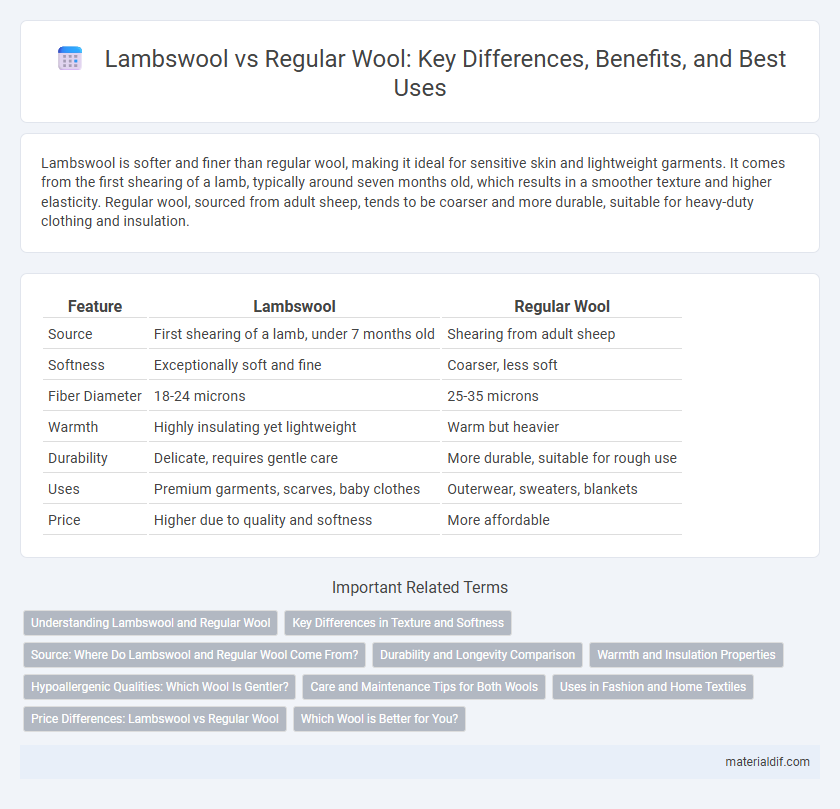Lambswool is softer and finer than regular wool, making it ideal for sensitive skin and lightweight garments. It comes from the first shearing of a lamb, typically around seven months old, which results in a smoother texture and higher elasticity. Regular wool, sourced from adult sheep, tends to be coarser and more durable, suitable for heavy-duty clothing and insulation.
Table of Comparison
| Feature | Lambswool | Regular Wool |
|---|---|---|
| Source | First shearing of a lamb, under 7 months old | Shearing from adult sheep |
| Softness | Exceptionally soft and fine | Coarser, less soft |
| Fiber Diameter | 18-24 microns | 25-35 microns |
| Warmth | Highly insulating yet lightweight | Warm but heavier |
| Durability | Delicate, requires gentle care | More durable, suitable for rough use |
| Uses | Premium garments, scarves, baby clothes | Outerwear, sweaters, blankets |
| Price | Higher due to quality and softness | More affordable |
Understanding Lambswool and Regular Wool
Lambswool, harvested from a lamb's first shearing at around seven months old, is finer, softer, and more elastic compared to regular wool, which comes from older sheep and has coarser fibers. The micron count for lambswool typically ranges between 17-19 microns, providing superior softness and comfort, whereas regular wool often ranges from 20 to 30 microns, resulting in a more durable but rougher texture. Understanding these fiber differences is essential for applications in clothing and textiles, where lambswool is favored for delicate wear and regular wool for rugged, insulating garments.
Key Differences in Texture and Softness
Lambswool, harvested from the first shearing of a young sheep typically under seven months old, is finer and softer compared to regular wool, which comes from mature sheep. The fibers of lambswool measure around 16-19 microns in diameter, offering a smooth, plush texture prized for next-to-skin comfort. Regular wool fibers are coarser, usually 25 microns or more, resulting in a rougher feel that provides greater durability but less softness than lambswool.
Source: Where Do Lambswool and Regular Wool Come From?
Lambswool is sourced from the first shearing of a sheep, typically around seven months old, resulting in fine, soft fibers prized for their smooth texture. Regular wool, on the other hand, is harvested from mature sheep, yielding coarser and stronger fibers ideal for durability. The distinction in source age significantly influences the fiber quality, softness, and end-use applications of lambswool versus regular wool.
Durability and Longevity Comparison
Lambswool, sourced from the first shearing of young sheep, tends to be softer but less durable than regular wool, which comes from mature sheep and is more robust. Regular wool fibers have a thicker diameter, enhancing resistance to wear and extending the garment's longevity. Investing in regular wool products typically offers greater durability, making them suitable for heavy use, whereas lambswool excels in softness and comfort but may show signs of wear sooner.
Warmth and Insulation Properties
Lambswool, sourced from the first shearing of a lamb, offers superior warmth and finer insulation properties compared to regular wool due to its softer, denser fibers that trap heat more effectively. Regular wool, often coarser and thicker, provides durability and moderate insulation but may lack the same level of softness and thermal efficiency found in lambswool. The enhanced loft and breathability of lambswool make it an ideal choice for garments requiring exceptional warmth without bulk.
Hypoallergenic Qualities: Which Wool Is Gentler?
Lambswool is known for its finer fibers, making it naturally softer and more hypoallergenic compared to regular wool, which can contain coarser fibers that may irritate sensitive skin. The reduced lanolin content in lambswool further minimizes allergic reactions, enhancing its suitability for individuals prone to wool allergies. These hypoallergenic qualities position lambswool as the gentler and more comfortable option for those seeking soft, skin-friendly wool products.
Care and Maintenance Tips for Both Wools
Lambswool, being the soft undercoat obtained from young sheep, requires gentle hand washing with cold water and mild detergent to preserve its softness and prevent shrinkage. Regular wool, sourced from mature sheep, benefits from careful washing in lukewarm water with wool-specific detergents and should be dried flat to avoid distortion. Both wools should be stored in breathable garment bags with cedar blocks or lavender sachets to deter moths and maintain fiber quality.
Uses in Fashion and Home Textiles
Lambswool, prized for its softness and fine fiber diameter, is often used in high-end fashion garments like sweaters, scarves, and luxury knitwear, providing exceptional comfort and warmth. Regular wool, being more durable and coarser, is commonly utilized in home textiles such as rugs, upholstery, and heavier outerwear that require greater resilience and insulation. The distinct textures and properties of lambswool versus regular wool influence their applications, with lambswool favored for close-to-skin wear and regular wool preferred for structured and enduring fabric uses.
Price Differences: Lambswool vs Regular Wool
Lambswool is generally more expensive than regular wool due to its finer fibers harvested from young sheep during their first shearing, resulting in superior softness and warmth. The higher production costs and limited availability of lambswool contribute to its premium price point compared to standard wool, which is coarser and more abundant. Consumers typically pay a price premium of 20-30% for lambswool products over regular wool items in the market.
Which Wool is Better for You?
Lambswool, harvested from the first shearing of young sheep, offers exceptional softness, making it ideal for sensitive skin and lightweight garments. Regular wool, sourced from mature sheep, provides greater durability and warmth, suitable for heavy-duty outerwear and insulation. Choosing between lambswool and regular wool depends on your need for softness versus durability and thermal efficiency.
Lambswool vs Regular Wool Infographic

 materialdif.com
materialdif.com